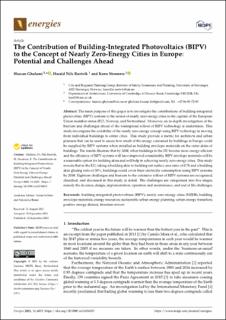| dc.contributor.author | Gholami, Hassan | |
| dc.contributor.author | Røstvik, Harald Nils | |
| dc.contributor.author | Steemers, Koen | |
| dc.date.accessioned | 2021-10-18T15:39:19Z | |
| dc.date.available | 2021-10-18T15:39:19Z | |
| dc.date.created | 2021-09-26T10:05:37Z | |
| dc.date.issued | 2021-09 | |
| dc.identifier.citation | Gholami, H., Nils Røstvik, H., & Steemers, K. (2021). The Contribution of Building-Integrated Photovoltaics (BIPV) to the Concept of Nearly Zero-Energy Cities in Europe: Potential and Challenges Ahead. Energies, 14(19), 6015 | en_US |
| dc.identifier.issn | 1996-1073 | |
| dc.identifier.uri | https://hdl.handle.net/11250/2823742 | |
| dc.description.abstract | The main purpose of this paper is to investigate the contributions of building-integrated photovoltaic (BIPV) systems to the notion of nearly zero-energy cities in the capitals of the European Union member states (EU), Norway, and Switzerland. Moreover, an in-depth investigation of the barriers and challenges ahead of the widespread rollout of BIPV technology is undertaken. This study investigates the scalability of the nearly zero-energy concept using BIPV technology in moving from individual buildings to entire cities. This study provide a metric for architects and urban planners that can be used to assess how much of the energy consumed by buildings in Europe could be supplied by BIPV systems when installed as building envelope materials on the outer skins of buildings. The results illustrate that by 2030, when buildings in the EU become more energy-efficient and the efficiency of BIPV systems will have improved considerably, BIPV envelope materials will be a reasonable option for building skins and will help in achieving nearly zero-energy cities. This study reveals that in the EU, taking a building skin to building net surface area ratio of 0.78 and a building skin glazing ratio of 30%, buildings could cover their electricity consumption using BIPV systems by 2030. Eighteen challenges and barriers to the extensive rollout of BIPV systems are recognised, classified, and discussed in this study in detail. The challenges are categorised into five stages, namely the decision, design, implementation, operation and maintenance, and end of life challenges. View Full-Text | en_US |
| dc.language.iso | eng | en_US |
| dc.publisher | MDPI | en_US |
| dc.relation.uri | https://www.mdpi.com/1996-1073/14/19/6015 | |
| dc.rights | Navngivelse 4.0 Internasjonal | * |
| dc.rights.uri | http://creativecommons.org/licenses/by/4.0/deed.no | * |
| dc.subject | energi | en_US |
| dc.subject | bærekraftig energi | en_US |
| dc.subject | urban energi | en_US |
| dc.title | The Contribution of Building-Integrated Photovoltaics (BIPV) to the Concept of Nearly Zero-Energy Cities in Europe: Potential and Challenges Ahead | en_US |
| dc.type | Peer reviewed | en_US |
| dc.type | Journal article | en_US |
| dc.description.version | publishedVersion | en_US |
| dc.rights.holder | © By the Author(s) 2021 | en_US |
| dc.subject.nsi | VDP::Teknologi: 500 | en_US |
| dc.source.volume | 14 | en_US |
| dc.source.journal | Energies | en_US |
| dc.source.issue | 19 | en_US |
| dc.identifier.doi | 10.3390/en14196015 | |
| dc.identifier.cristin | 1938635 | |
| dc.source.articlenumber | 6015 | en_US |
| cristin.ispublished | true | |
| cristin.fulltext | original | |
| cristin.qualitycode | 1 | |

